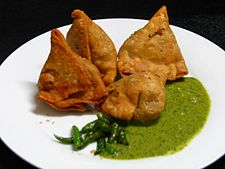My second post is about something that is very close to my heart and probably all our desi hearts. I’ve never met a person in my life who can resist the crispy charm of Samosa and if you are the rarest of rare, CLICK ON THE RED BUTTON ON THE TOP RIGHT IMMEDIATELY, because I refuse to to acknowledge people who can’t enjoy the delicious crisp of Samosas. I refuse to be part of a society that doesn’t give Samosa the Iconic status it deserves. SAMOSA FOR PRESIDENT! (oK yeh thoda zyaada ho gaya)
charm of Samosa and if you are the rarest of rare, CLICK ON THE RED BUTTON ON THE TOP RIGHT IMMEDIATELY, because I refuse to to acknowledge people who can’t enjoy the delicious crisp of Samosas. I refuse to be part of a society that doesn’t give Samosa the Iconic status it deserves. SAMOSA FOR PRESIDENT! (oK yeh thoda zyaada ho gaya)
Current day Samosas
The current day samosas are small, crispy, flaky pastries that are usually deep-fried. They are stuffed with an assortment of fillings ranging from minced meat with herbs and spices to vegetables such as cauliflower and potatoes. In Bengal one finds samosas filled with sweetened reduced milk that go straight from the frying pan to a syrup wash. But whatever the filling, samosas are a treasured snack–the perfect companion to a hot cup of Chai.
Samosa: Origins
The SAMOSA probably traveled to India along ancient trade routes from Central Asia. Small, crisp mince-filled triangles that were easy to make around the campfire during night halts, then conveniently packed into saddlebag as snacks for the next day’s journey. The Indian samosa is the best known of an entire family of stuffed pastries or dumplings popular from Egypt and Zanzibar to Central Asia and West China. Arab cookery books of the 10th and 13th Centuries refer to the pastries as sanbusak (the pronunciation still current in Egypt, Syria, & Lebanon), sanbusaq or sanbusaj, all reflecting the early medieval form of the Persian word: sanbosag. Interestingly, there is a poem by Ishaq ibn Ibrahim-al-Mausili (9th Century) praising the sanbusaj.
By the early 14th Century, it was not only a part of Indian cuisine but also food fit for a king. Amir Khusrao, prolific poet of Delhi royalty, observed in 1300 that the royal set seemed partial to the “samosa prepared from meat, ghee, onion and so on”. In 1334, the renowned traveler Ibn Battuta wrote about the sambusak: “minced meat cooked with almonds, pistachios, onions and spices placed inside a thin envelop of wheat and deep-fried in ghee”. And the samosa obtained a royal stamp with its inclusion in the Ain-i-Akbari which declared that among dishes cooked with wheat there is the qutab, “which the people of Hind called the sanbusa“.
So Bacchon aaj kya seekha hamne? (OMG! This Blackboard theme makes feel sic). Well, i’ll tell you what I learnt; I am not the only mad person on planet earth to write poems n articles on Samosa. Now let’s wrap it up with my foodie ka funda.
Foodie ka Funda No.3:
Never order food in excess of your weight! (Don’t look at me like that, I exaggerated for effect)
Comment, Review or Follow my blog on WP and on Twitter #foodiekafunda
To make delicious Samosas click play :

